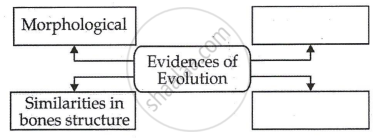Advertisements
Advertisements
प्रश्न
- Define vestigial organs.
- Write names of any two vestigial organs in the human body.
- Write name of those animals in which these vestigial organs are functional.
उत्तर
- Vestigial organs are degenerate organs that are inadequately developed and non-functional. They could be useful in certain related and unrelated species, as well as in ancestors.
- Vestigial organs in humans are:
- Appendix
- Wisdom teeth
- Ear Muscles
- Tail-bone
-
- Appendix is fully functional in ruminants for digestion of cellulose.
- Ear pinna is useful in many animals like rabbits, cows, horses, etc.
APPEARS IN
संबंधित प्रश्न
What are vestigial organs?
Study the following statements:-
I. Wings of birds and wings of bats are homologous organs.
II. Wings of birds and wings of insects are modified forelimbs.
III. Wings of birds and wings of insects are analogous organs.
IV. Wings of birds and forelimbs of horse are homologous organs.
The correct statements are
(A) I and II
(B) II and III
(C) III and IV
(D) I and IV
If you are asked to select a group of two vegetables, out of the following, having homologous structures which one would you select?
(a) Carrot and radish
(b) Potato and sweet potato
(c) Potato and tomato
(d) Lady finger and potato
Which of the following is a correct set of homologous organs?
(a) Forelimbs of frog, bird and lizard
(b) Spine of cactus and thorn of bougainvillea
(c) Wings of bat and wings of butterfly
(d) Wings of a bird and wings of a bat
Can the wing of a butterfly and the wing of a bat be considered homologous organs? Why or why not?
Enlist any four sequential evolutionary names of human ancestors.
What are homologous organs?
Out of bacteria, spider, fish and chimpanzee, which organism has a better body design in evolutionary terms? Give reason for your answer.
Some dinosaurs had feathers although they could not fly birds have feathers that help them to fly. In the context of evolution, this means that ______
Identify the following pairs as homologous and analogous organs:
(i) Sweet potato and potato
(ii) Eye of octopus and eye of mammals
(iii) Thorns of Bougainvillaea and tendrils of Cucurbits
(iv) Fore limbs of bat and whale
Vestigial organ ______ present in human body is proof of evolution.
Answer the following question.
Wisdom teeth : Vestigial organs :: Lungfish : ....................
Complete the following chart:

Explain any three molecular (genetic) evidences in favour of organic evolution.
Define fossil.
Very short answer question.
What are homologous organs?
_____________ is a vestigial organ in human beings.
Find an odd one out.
Match the following.
| Column A | Column B |
| 1) Morphological evidences | a) Tail-bone or wisdom teeth |
| 2) Paleontological evidences | b) Leaf venation |
| c) Fossils |
Complete the flowchart.

Observe the following images and answer the questions.

- Which evolutionary evidences are indicated in the given picture?
- How are they formed?
- Which method is used to measure their age or their time?
Explain any five types of evidence that support the theory of evolution.
A human hand, a front leg of a cat, a front flipper of a whale and a bat’s wing look dissimilar and adapted for different functions. What is the name given to these organs?
Select vestigial organs from the following.
Basic principles of embryonic development were pronounced by:
The process of mating of individuals, which are more closing related than the average of the population to which they belong is called ______.
How do we compute the age of a living tree?
Give an example for convergent evolution and identify the features towards which they are converging.
How do we compute the age of a fossil?
How do we compute the age of a rock?
Explain divergent evolution in detail. What is the driving force behind it?
Complete the following diagram:

What is the function of the appendix of our digestive system?
As shown in figure below some organisms that share a common ancestor have features that have different functions, but similar structures.

These are known as ______. Give example.
Write a note on the significance of Palaeontology.
Industrial melanism was highlighted by ______.
Industrial melanism in England after 1850 is an excellent example of Natural selection. Explain how?
Complete the following conceptual picture:

Write names of some vestigial organs in the human body.
